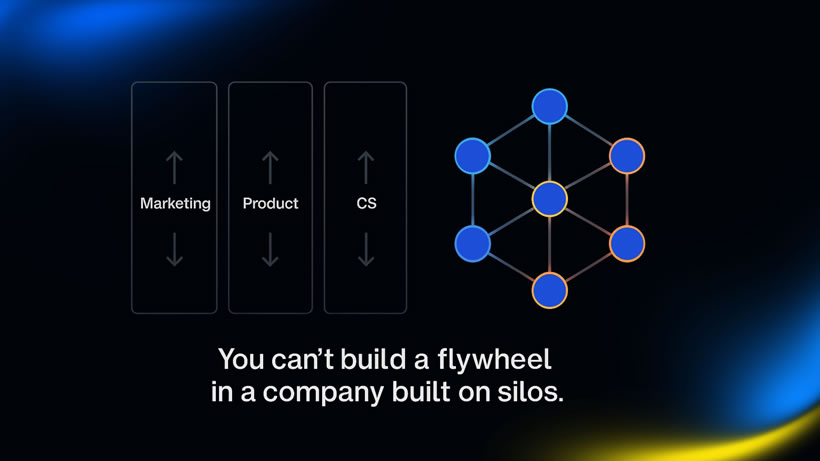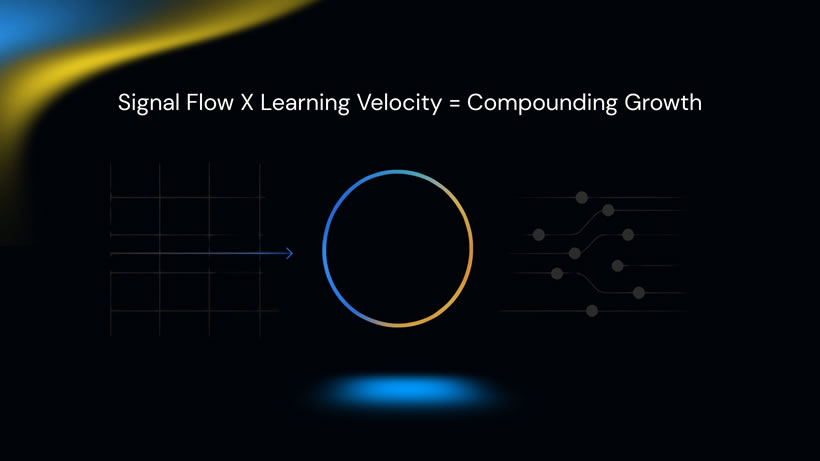Summary
Everyone’s chasing funnel optimization. Improving conversion rates. Reducing drop-off. A/B testing CTAs. Shortening the path from awareness to purchase. It’s not wrong. It’s just incomplete because while you’re optimizing a linear path, the market stopped moving linearly a decade ago.
Buyers don’t start at the top of your funnel and march obediently downward anymore. They jump in mid-journey. They loop back. They research for months, then decide in an afternoon. They talk to users before they talk to you. They evaluate you across seven different touchpoints you’ll never see.
The funnel was built for a world where you controlled the information flow. That world is gone.
The best teams aren’t optimizing funnels anymore. They’re building flywheels—systems where every output becomes an input, where momentum compounds, where growth becomes self-reinforcing.
And they’re doing it by chasing something most teams don’t even measure: signal density.
Why The Funnel Model Is Dying
I’ve spent 25 years watching the funnel metaphor dominate marketing strategy. And for most of that time, it made sense.
Marketing generated awareness. Sales converted it. Customer success retained it. Each stage was owned by a different team, measured by different metrics, optimized in isolation.
The funnel worked because the buying journey was relatively predictable. You could map it. You could measure where people dropped off. You could optimize each stage independently.
But three things broke that model:
- Information asymmetry collapsed
Buyers used to need you to understand your product. Now they’ve read twelve reviews, watched six demos on YouTube, talked to three of your customers, and joined a Slack community where users share workarounds—all before they ever fill out a form on your website.
You don’t control the narrative anymore. The market does.
- The buying journey fragmented
The old model assumed a sequence: awareness → consideration → decision → purchase.
Now it’s: awareness through a podcast mention → consideration via a Reddit thread → trial because a colleague mentioned it → decision after talking to your community → purchase after three months of evaluation you never saw.
There’s no funnel. There’s a network of interconnected touchpoints that don’t happen in order.
- Growth became everyone’s job
Marketing doesn’t generate leads that sales converts anymore. Product generates users that marketing educates. Community generates advocates that sales leverages. Customer success generates case studies that marketing amplifies.
The boundaries dissolved. The funnel metaphor couldn’t keep up.
And yet, most teams are still trying to optimize a model that doesn’t reflect how their customers actually buy.
What Signal Density Actually Means
When I talk to growth teams now, I ask a different question than I used to.
Not: “What’s your conversion rate?”
But: “How fast can you learn what’s working?”
That’s signal density.
Signal density is the speed at which feedback moves through your system.
How quickly does product usage data reach your marketing team?
How fast can creative respond to what’s resonating in sales conversations?
How rapidly do you surface patterns from customer success conversations back to product positioning?
The teams that win aren’t the ones with the highest conversion rates. They’re the ones with the tightest feedback loops between product, creative, and data. Because in a market where tactics have a shelf life of months, not years, the only sustainable advantage is learning velocity.
You need to know what’s working faster than your competitors do. You need to adapt to what you learn faster than the market shifts. You need signal moving through your organization at speed—not getting trapped in silos, delayed by review cycles, or lost in handoffs. That’s what separates teams that scale from teams that plateau. Not better tactics. Better signal flow.

The Anatomy of a Modern Growth Flywheel
The flywheel metaphor isn’t new. HubSpot popularized it years ago. But most companies use it as a diagram, not a system.
They draw circles with arrows. They put “attract,” “engage,” “delight” in pretty boxes. Then they go back to optimizing their funnel because they don’t know how to operationalize the flywheel.
Here’s what it actually looks like when you build one:
- Product generates signal
Every product interaction is data. Not just “did they convert”—but how they’re using it, where they’re getting value, what they’re struggling with, who they’re inviting.
Most companies track usage. Few translate it into marketing signal.
The teams that do ask: What do power users do differently? What features create habit formation? What workflows lead to expansion? What moments create advocacy?
Then they feed that back into everything: messaging, positioning, content, sales enablement, customer education.
- Marketing amplifies patterns
Marketing’s job isn’t to generate demand anymore. It’s to find the patterns in what’s already working and make them louder.
You look at what messages are resonating in sales calls. What pain points are showing up in support tickets. What content is getting shared by users. What case studies are closing deals.
Then you build systems to amplify those patterns: content that reflects real user language, campaigns that target the segments where product-market fit is strongest, creative that shows the actual moments of value users experience.
You’re not inventing a story. You’re surfacing the one that’s already there.
- Data closes the loop
Every marketing touchpoint generates new data. Every sales conversation surfaces new insights. Every product session reveals new patterns.
The question is: how fast does that data reach the people who can act on it?
In most organizations, it takes weeks or months. By the time insights reach the strategy layer, they’re stale.
In high-signal-density organizations, it takes days or hours. Product teams see what marketing messages are driving signups. Marketing sees what product features are driving retention. Sales sees what use cases are expanding fastest.
The loop closes continuously. Learning compounds.
- Momentum becomes self-reinforcing
This is where the flywheel actually becomes a flywheel: when the system starts generating its own momentum.
Product usage creates case studies. Case studies create content. Content creates awareness. Awareness creates signups. Signups create product usage. The loop accelerates.
Every cycle makes the next one easier. Your best customers start doing your marketing for you. Your content library becomes a self-serve sales engine. Your product becomes its own proof point.
You stop pushing. The system starts pulling.

Why Most Companies Can’t Build This
I’ve watched dozens of companies try to shift from funnel thinking to flywheel systems. Most fail. Not because they don’t understand the concept, but because they can’t overcome three structural barriers:
Organizational silos
Your marketing team reports to the CMO. Your product team reports to the CPO. Your customer success team reports to the COO.
They have different OKRs. Different dashboards. Different quarterly priorities. Marketing is optimizing for pipeline. Product is optimizing for engagement. Customer success is optimizing for retention. Nobody’s optimizing for signal flow between them.
The flywheel requires coordination that most org structures actively prevent. You can’t build it without breaking down the walls.
Incompatible incentives
Marketing gets measured on leads generated. Sales gets measured on deals closed. Product gets measured on feature velocity. Customer success gets measured on churn. All of those metrics can improve while the flywheel stalls. Because none of them measure the speed of learning or the quality of signal flow. You can’t build a flywheel when your incentive structure still rewards funnel thinking.
Tool sprawl
Your product data lives in Amplitude. Your marketing data lives in HubSpot. Your sales data lives in Salesforce. Your customer data lives in Zendesk.
Each team has its own stack. Each stack has its own dashboard. Nobody has a unified view of the signal. So insights get trapped in tools. They don’t flow. They don’t compound. You can’t build a flywheel when your data infrastructure is designed for silos.

What Changes When Marketing Becomes the Growth System
Here’s the shift that most executives miss:
Marketing isn’t a stage of growth anymore. It is the growth system.
Not the team that generates leads for sales to convert. The function that connects product to market, translates signal into strategy, and ensures every part of the organization learns from what’s working. That requires a different kind of marketing leader.
Not someone who runs campaigns. Someone who builds systems.
Not someone who creates content. Someone who orchestrates signal flow.
Not someone who owns a channel. Someone who connects all the channels into a coherent learning loop.
I’ve seen this evolution happening in real-time at the companies that scale fastest: Marketing sits between product and go-to-market. They translate product insights into market narratives. They translate market feedback into product priorities. They ensure the loop closes continuously.
They own positioning—but they derive it from product data and user language, not brand workshops.
They run campaigns—but they design them as experiments that generate signal, not just pipeline.
They create content—but they build it from patterns they see in customer success conversations, support tickets, and sales calls.
They become the connective tissue that turns isolated functions into a learning system.

How To Build for Signal Density
If you want to shift from funnel optimization to flywheel thinking, you need to change three things:
- Measure learning velocity, not just conversion velocity
Stop asking: “How many leads did we generate?”
Start asking: “How fast did we learn what message resonates? How quickly did we adapt to what we learned? How rapidly did that insight reach the teams that could act on it?”
Add metrics like:
- Time from insight to action
- Number of experiments run per quarter
- Speed of signal propagation between teams
- Quality of pattern recognition in customer data
These tell you whether you’re building a learning system or just running campaigns.
- Design for feedback loops, not handoffs
Every time you create a handoff—marketing to sales, sales to customer success, customer success to product—you create friction in the signal flow.
Redesign your processes to close loops:
- Product teams join sales calls to hear objections firsthand
- Marketing teams access product usage data in real-time
- Customer success insights feed directly into messaging frameworks
- Sales conversations generate content topics, not just pipeline
The faster signal moves, the faster you learn. The faster you learn, the faster you grow.
- Hire for synthesis, not just execution
The bottleneck in most growth systems isn’t execution. It’s synthesis.
You have the data. You have the insights. What you’re missing is someone who can connect them—who can see the pattern across product usage, market feedback, and competitive dynamics, then translate it into strategy. That’s not a traditional marketing skillset. It’s closer to product management. Or data science. Or strategic ops. You need people who can move between product, marketing, and data fluently. Who can spot signal in noise. Who can build systems, not just run campaigns. That’s the profile that scales in a flywheel model.
Why This Matters More in Hybrid GTM Models
If you’re running a pure PLG motion or a pure enterprise sales motion, the funnel model might still work. Barely. But if you’re doing both—if you have a freemium product that feeds enterprise deals, if you’re trying to bridge self-serve and sales-assisted, if you’re navigating the awkward middle between product-led and sales-led—the funnel metaphor completely breaks because your buyers are taking both paths. Sometimes simultaneously. Sometimes switching between them mid-journey.
A user signs up for the free tier. Their colleague evaluates it. Their manager asks for a demo. The budget holder requires an enterprise contract. Someone in procurement compares you to three competitors. The original user advocates for you in an internal meeting you’ll never see.
Where’s the funnel? There isn’t one. There’s just a complex web of interactions where product experience, marketing narrative, sales conversations, and peer recommendations all influence the outcome—often in ways you can’t measure.
The only way to navigate that complexity is with high signal density. With systems that let you see patterns across all those touchpoints. With feedback loops that help you understand what’s actually working. You can’t optimize your way through that with A/B tests and conversion rate improvements. You need a flywheel. You need signal moving fast. You need the whole organization learning from what’s working and adapting in real-time.
The Bottom Line
The funnel made sense when buying journeys were linear and you controlled the information flow. Those conditions don’t exist anymore.
Buyers don’t move through stages in order. They don’t need you to educate them. They don’t follow the path you laid out. They evaluate you across a dozen touchpoints you’ll never see. They form opinions before you know they exist. They make decisions based on signals you’re not tracking.
The teams that win in that environment aren’t the ones with the most optimized funnels.
They’re the ones with the tightest feedback loops. The fastest learning cycles. The highest signal density between product, marketing, and data.
They’ve stopped treating marketing as a stage of growth and started treating it as the operating system that connects all the other stages.
They’ve stopped pushing prospects through a funnel and started building systems where momentum compounds on its own.
They’ve stopped optimizing for conversion and started optimizing for learning velocity.
Because in a world where tactics expire in months and markets shift in weeks, the only sustainable advantage is the speed at which you can adapt. Not your current playbook. Your ability to generate the next one. Your signal density versus funnel metrics. That’s why the funnel is dying and why the flywheel, done right, not just diagrammed, is rising. Again.

